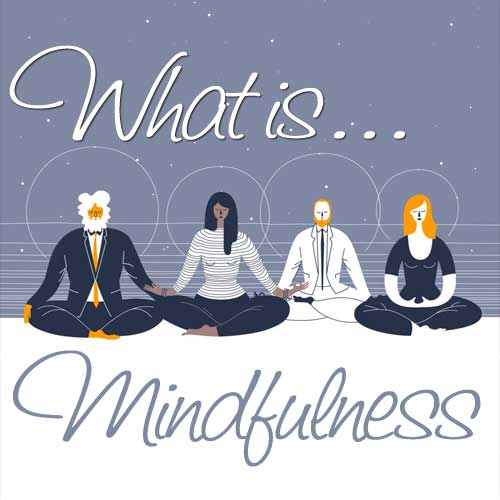We hear the word mindful so often, it is almost a constant reminder, but what is Mindfulness? Being mindful is a verb that describes a practice of paying attention to what is happening now. Being mindful is something that is naturally part of ourselves, whether we choose to cultivate it or not. What we are doing, what we are feeling and what we are thinking are all parts of practicing mindfulness. This practice is best learned during active, daily practice. When we observe our thoughts, feelings and actions we are learning about ourselves without judging why we think, feel or do things the way we do them. What we observe is neither good or bad in the moment, this observation is meant to teach us what we do and how we do it as we respond to the things we can’t control, like the weather, other people’s behaviors or any other factor that we can only respond to.
“Mindfulness is the ability to know what’s happening in your head at any given moment without getting carried away by it.”
– Dan Harris
Why would we want to practice mindfulness? Mindfulness can be the buffer between our emotions and our reaction. The first time I heard the term was when I was at a therapy session. The very reason people go to a therapist is to learn how to change behaviors that are causing harm to themselves or others, so it makes sense that it is a popular word among mental health professionals.
If we all were walking around in our mind’s perception of perfect health, with perfect relationships and perfect bank accounts, we might not be seeking help to reach, or at least come as close to, these goals as we can. When we are practicing mindfulness, research has shown, when we train our brain to be mindful, we are changing the physical structure of our brain. So while you are making choices about what your wellness goals might be, and even while you are working on your goals, being mindful is a great way to learn how we work and decide how to overcome our bad habits, or learned behaviors that are not serving us in the way we would like them to.
Where did the idea of Mindfulness come from?
The practice of mindfulness is rooted in Buddhist and Hindu teachings which includes a journey toward enlightenment by paying attention to and being aware and present to our behaviors. If you do not aspire to Buddhism or Hinduism, don’t freak out. These teachings are common among many belief systems, even Christianity. The golden rule is generally accepted by most people and is the principle of treating others as you want to be treated, is very similar to the teachings of Jesus:
“Teacher, which is the greatest commandment in the law?”
Jesus said to him, “‘You shall love the Lord your God with all your heart, with all your soul, and with all your mind.’ This is the first and greatest commandment. And the second is like it: You shall love your neighbor as yourself. On these two commandments hang all the Law and the Prophets.”
Matthew 22:36-40
Mindfulness came to Western culture mainly by Jon Kabat-Zinn, a professor at the University of Massachusetts in the 1970’s. He created a program called Mindfulness-Based Stress Reduction to treat chronic pain. He had studied mindfulness with several Buddhists teachers and he had discovered that patients would create behaviors to avoid pain, but these behaviors often caused more harm than good. He found that when people used awareness and acceptance techniques, they had more success.
What is the goal of Mindfulness?
- Set aside time each day
- Observe the present moment as it is
- Let judgements go
- Return to mindfulness when we are distracted
- Forgive ourselves when our minds wander
The goal of mindfulness is gain a perspective of a person’s personal consciousness and identity by exploring our mind. As we practice this the normal distractions and thoughts that interrupt us, will become less and less. By learning about ourselves, without judging our behavior as good or bad, we learn to accept them. Once we have learned our behaviors we are able to be objective of them, instead of defensive of ourselves.
Why would we want to do this? When we are defending ourselves we are functioning, almost completely in our emotions. When we are being objective we are able to say, this is what I do when this happens and form an action plan that says: I want to do this, when this happens. Emotions are important, but their function can be limiting if we use them beyond their purpose: to let us know that something needs attention. When we are using the logical part of our mind, we are able to respond to those emotions in a healthy manner, instead of relying on old, bad habits.
“The goal if mindfulness is not that we become rendered to a lifeless, non-judgmental blob but that we learn how to respond wisely to things that happen around you.”
– Dan Harris
For instance, I have a bad habit of over-eating or under-eating when I am stressed out. Sometimes this is because stress activates other chronic conditions in me that cause digestive issues, but sometimes it is because this is a behavior I learned while growing up. I have been working on this bad habit for over 20 years and it has taken a lot of effort on my part. But once I accepted what my behaviors were, I realized that I could create action plans.
Some of these action plans are:
- Not keeping trigger foods in the house unless we are having a party
- Never eating out of the container the chips or ice cream were purchased in
- Using smaller dishes when consuming these foods so that I am limited to a serving
- Practicing delayed gratification
- Letting myself only mindlessly eat raw vegetables, when I am snacky so that I can fill up on calories that also include good nutrition and a lot of water.
When I am in the mode of not eating, meals become times to fuel my body. Since I am on a pretty strict medication schedule, this is made easier because certain medications I take need to be taken with food.
There are many types of mindfulness-based therapies that can be used to address several types of behaviors:
- Anxiety
- Pain
- Relaxation
- Stress
Mindfulness can even help us if we want to change behaviors or belief systems because mindfulness is a form of meditation that can be developed inside formal meditation but also in everyday activities like taking a walk, having a conversation with someone or journaling.
How to Practice Mindfulness
By putting space between ourselves and our learned responses we make time for ourselves to not worry about the past or the future. We also learn to be more forgiving of ourselves, and maybe of others, while cultivating patience and peace.
How to Meditate
- Sit comfortably
- Notice what your legs are doing
- Straighten your shoulders, back and torso
- Notice what your arms are doing
- Soften your gaze, you don’t have to close your eyes
- Feel your breath through your nose and out your mouth
- Notice when your mind wanders from your breath
- Be kind about your wandering mind
- When you are ready, gently lift your gaze or open your eyes
- Notice your thoughts and emotions
Practicing mindfulness can help you feel more at peace. You might also find yourself feeling kinder and more patient with yourself and with others. Some people find they become more playful and intentional about enjoying others once they get the hang of mindfulness. When you learn how you think and react to the world around you, you are in a better position to consider positive changes that will benefit your Wellness Plan and your relationships.
Mindfulness is a great decision-making tool because remaining mindful means you are present in your thoughts, feelings, bodily sensations and surrounding environment. When we use mindfulness to make decisions our process becomes a thoughtful, cognitive experience instead of impulsively reacting to immediate needs.
When we use mindfulness in our every-day decision process we might enjoy:
- Early identification of decisions that need to be made
- More creative problem-solving
- More ethical evaluations of situations
- Improved ability to recognize the limits of knowledge
- Improved ability to identify trade-offs and unintended consequences of potential decisions
Mindfulness meditation creates space in our minds to think. Just as it can help us in our personal lives, mindfulness has become a tool that large corporations use because they make good leaders, on a personal level, these tools can also help us become better listeners and communicators, which will make us better people in general.
At Wellness Works NW we want you to be the best, you, you can be. If you are needing someone to cheer you on, help you create a comprehensive wellness plan or just want prayer, please Contact Us today and someone from Our Team will be ready to help you.
I hope this article answered questions you had and was easy to understand. If you would like us to write about a particular topic that you can’t find on this site, please send us an email on our Dear Jamie page and someone from Our Team will be glad to research and write about your topic.
Resources and Start Learning More:
- Image Credit: Getting Started with Mindfulness by Mindful Staff
- Matthew 22:36-40 as found in the New King James Bible
- Mindfulness: A Powerful Decision-Making Tool by Institut Européen
d’Administration des Affaires (INSEAD) Staff - Mindfulness by Psychology Today Staff
- Why Mindfulness Is a Superpower: An Animation by Dan Harris
Related Articles
- Pain Awareness & Drug-Free Pain Management Awareness
- What is a Wellness Plan?
- National Eating Disorders Awareness Week 2020
- The Benefits of Body Scan Meditation
- Learning About Generalized Anxiety Disorder
I hope this article helps Fuel Your Wellness. Please leave your comments below.
 Summer D Clemenson is a co-owner Clemenson Enterprises, LLC and Wellness Works NW. Summer her wife, Karen G Clemenson’s personal motto is Creativity, Honesty & Positivity are a must! This mantra helps them stay community and wellness minded in all they do. Summer is an Independent Wellness Advocate at dōTERRA. Summer also writes poetry and inspirational blogs @ GoodTimesAlways.com. Her crochet art can be viewed and purchased @ KnottyWares.com & she loves special orders!
Summer D Clemenson is a co-owner Clemenson Enterprises, LLC and Wellness Works NW. Summer her wife, Karen G Clemenson’s personal motto is Creativity, Honesty & Positivity are a must! This mantra helps them stay community and wellness minded in all they do. Summer is an Independent Wellness Advocate at dōTERRA. Summer also writes poetry and inspirational blogs @ GoodTimesAlways.com. Her crochet art can be viewed and purchased @ KnottyWares.com & she loves special orders!













